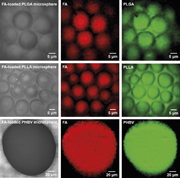현재 사용 중인 언어로는 이 페이지를 사용할 수 없습니다. Google Translate을 사용하여
자동 번역된 페이지
를 볼 수 있습니다. Renishaw에게는 이 서비스를 제공할 책임이 없으며 번역 결과를 저희가 확인하지도 않았습니다.
추가로 도움이 필요하시면
저희에게 연락해 주십시오.
Microsphere antibiotic carriers
Microspheres - antibiotic carriers for the direct delivery of drugs to wound sites
18 October 2011
Microspheres - antibiotic carriers for the direct delivery of drugs to wound sites
Biodegradable microspheres are ideal drug carriers for antibiotics and for their direct application to sites of musculo-skeletal surgery. Understanding drug carrier formation and drug release efficiency is of paramount importance in optimising the design of drug delivery mechanisms.
Stringent sterilisation and aseptical environments are required during surgery to prevent microbial infection of the wound. Correct identification of pathogens allows the effective prevention and treatment of infection through the administration of appropriate antibiotics. Antibiotics such as fusidic acid (FA) are highly effective against Staphylococci, which commonly cause prosthetic joint infections.
Systemic delivery (indirectly to the site of treatment via blood stream or digestive system) of FA risks complications including the lack of blood vessels in some wound areas, as well as systemic side effects such as nausea and stomach pain. Research has shown that direct application of antibiotics to surgical sites offers significant advantages over systemic delivery; not only can higher tissue concentration levels and prolonged drug delivery be achieved, systemic side effects can simultaneously be avoided.
inVia StreamLine Plus™ Raman imaging was used to characterise FA-loaded microspheres constructed of different matrix materials – poly(DL-lactic-co-glycolic acid) (PLGA), poly(L-lactic acid) (PLLA) and poly (3-hydroxybutyric acid-co-3-hydroxyvaleric acid) (PHBV), to gain an understanding of the drug delivery mechanism.
The Raman images show the FA micro-domains in microspheres of the selected materials. Further investigation on the drug release efficacy of these microspheres will provide information for optimising the design of drug vehicles.
Acknowledgement: C. Yang, S. Gilchrist and H. Burt, Division of Pharmaceutics & Biopharmaceutics, Faculty of Pharmaceutical Science, The University of British Columbia, Vancouver, BC, Canada.

Figure - inVia StreamLine Plus™ Raman images show that whilst FA is confined in the micro domains, ubiquitous distribution of the microsphere polymer material was detected.
Downloads
- Microsphere antibiotic carriers [43kB]
-
 Microspheres
[619kB]
Microspheres
[619kB]
News updates
Register for regular news updates from Renishaw.